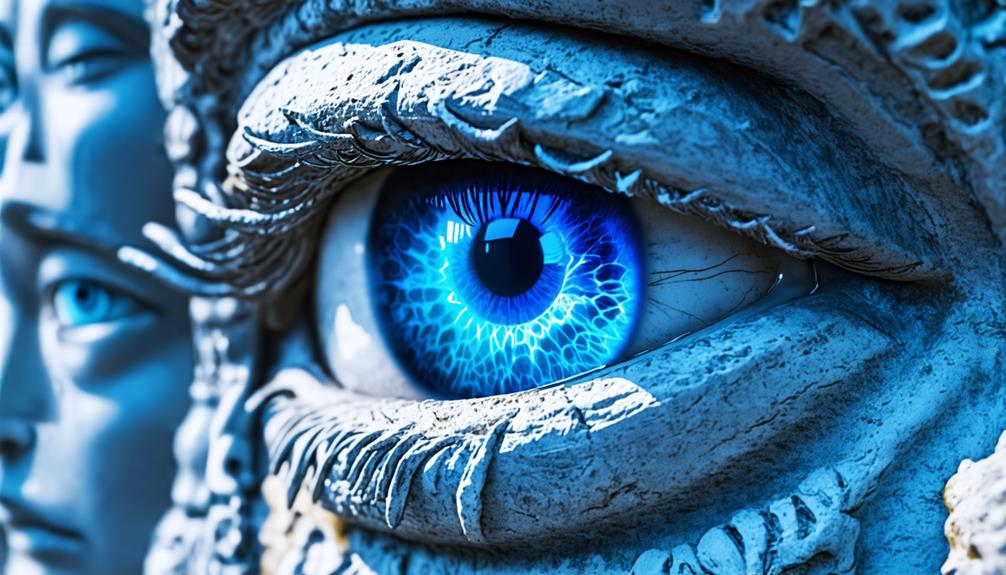Have you ever wondered why some people have blue eyes while others don't? It turns out that this distinctive trait can be traced back to a single ancestor who lived between 6,000 and 10,000 years ago. This revelation isn't just a fascinating bit of trivia; it's a window into human evolution and migration patterns. As you consider your own eye color or that of your loved ones, you might be surprised to learn how this genetic quirk has shaped populations around the world. The story behind blue eyes is more complex and far-reaching than you might imagine.
Key Takeaways
- A single genetic mutation 6,000-10,000 years ago led to the emergence of blue eyes.
- The mutation affects the HERC2 gene, which inhibits melanin production in the iris.
- All blue-eyed individuals share an identical genetic variation, indicating a common ancestor.
- Approximately 8-10% of the global population has blue eyes today.
The Blue-Eyed Genetic Mutation

A single genetic mutation that occurred 6,000 to 10,000 years ago is responsible for all blue-eyed individuals today. This fascinating discovery reveals that if you have blue eyes, you share a common ancestor with every other blue-eyed person on Earth.
The mutation affects the HERC2 gene, which in turn inhibits the OCA2 gene responsible for producing melanin, the pigment that gives eyes their brown color. This change occurred roughly 8000 years ago, leading to a reduction in melanin production and the emergence of blue eyes.
The shared ancestry among blue-eyed individuals is evidenced by the identical genetic variation found in their DNA. This neutral mutation has contributed to the diversity of eye color we see today, with approximately 8-10% of the global population now having blue eyes.
Tracing Our Ancestral Roots
Tracing blue-eyed individuals' ancestral roots leads us to a single common ancestor who lived between 6,000 and 10,000 years ago. This ancestor experienced a genetic mutation in the OCA2 gene, which regulates melanin production in the iris. This mutation resulted in the blue eye color we see today.
If you have blue eyes, you share a unique genetic marker with all other blue-eyed people, evidence of your shared ancestry. This marker confirms that you're descended from that one individual who first developed the trait approximately 6,000 to 10,000 years ago.
Over time, population dispersal led to the spread of this genetic mutation. Today, about 8-10% of the world's population has blue eyes, with a higher prevalence among those of European descent. This distribution reflects historical migration patterns and the gradual spread of the blue-eyed trait across populations.
Global Impact of Eye Color

While tracing ancestral roots reveals the origin of blue eyes, examining the global impact of eye color uncovers captivating patterns in population genetics and human migration.
You'll find that brown eyes dominate worldwide, with about 80% of people sharing this trait. However, blue eyes, resulting from a genetic mutation in the OCA2 gene that affects melanin production, are more common in specific regions.
You'll notice a higher prevalence of blue-eyed individuals in Scandinavian countries and a significant presence in the United States, where 27% of the population has blue eyes. This distribution reflects historical migration patterns, particularly among those of European descent.
Notably, all blue-eyed people likely share a common ancestor due to their unique genetic mutation. This connection highlights the far-reaching impact of a single ancestral trait on diverse populations across the globe.
Conclusion
You're part of a unique genetic lineage if you've got blue eyes. Your azure gaze connects you to a single ancestor who lived millennia ago.
This genetic quirk has spread across continents, shaping human diversity. As you look in the mirror, remember you're carrying a piece of ancient history.
It's a reminder of our shared origins and the fascinating ways genes can influence our appearance across generations.

Leave a Reply